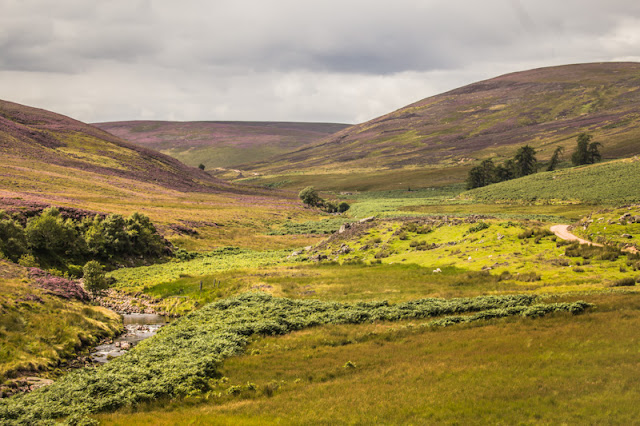Brian picked me up just before 8 o' Clock. It was about a two hour drive to the rendezvous at the James Hutton Institute farm at Glensaugh. The first bit of the journey was straight forward. A952 to the Toll of Birness, join the A90 and follow it through to the other side of Aberdeen to Laurencekirk. When we got near to our destination I switched on the Google sat nav on my phone. Mrs Google, I assume that was who was giving us directions took us down all sorts of small narrow roads through farmland. Fortunately is was early on Sunday morning and farmers were not up to drive their tractors along these roads as well.
The original plan was to stay in the Glensaugh area however an earlier scouting trip had not found many birds so it was decided to split the day into two with the second half walking through Glen Dye.
Glashaugh is a research farm. Unlike the vast majority of farms this one welcomes visitors and had a self-guided trail leads visitors on a circular tour, pointing out areas of geographic, social, landscape and historical change.
We didn't go on this trail but went along one of the other farm paths running beside Slack Burn. The first bird that was 'shouted' was a Red Kite. This was a year tick for Brian. Next it was a Buzzard, the first of many.
 |
| Buzzard |
 |
| Buzzard |
Next it was a Sparrowhawk flying high in the sky
 |
| Sparrowhawk |
The next birds were Wheatears and Stonechats.
 |
| Wheatear (top left) and Stonechat (bottom right) |
 |
| Confusion bird Juv. Wheatear |
We than went to Glen Dye. The road there goes over the Cairn o' Mount. I had never been on this road before. Its fame comes from the fact that it is often one of the first roads to be closed by the snow in winter. It is the main route from the Dee Valley to the South. At the top the views are fr reaching. I was told that you could see Edinburgh on a clear day. It was a clear day so I waved to my daughters who live there. I don't think they saw me.
Glen Dye, in contrast to Glensaugh held very few birds. A Grey Heron, some Wheatears, Stonechats and Meadow Pipits. A Wren was heard and a wagtail seen a great distance away and that was about it.
 |
| Grey Heron |
The nature highlight was a large herd of Red Deer across the valley.
 |
| Red Deer |
 |
| Glen Dye |
For this journey we used Brian,s in car DVD based sat nav. and apart from taking us on an unnecessary tour round the village of St Cyrus got us to our destination. The reserve car park was full, the roads leading to the reserve were being used as a car park. It was chaos. It was the first time that Brian and I had been here. Trevor was a frequent visitor and had never seen the place so crowded.
Eventually we did get a parking place, got all our gear out of the car and made for the top of the dunes. Straight away we saw the Whale or rather its splash.
 |
| Splash |
We did after a while see he animal itself but we didn't get any tail slapping or breaching displays. It was too busy feeding.
 |
| 'Thar She Blows' |
The reserve is a place I will have to go back to. There was a great variety of bird life. Peregrine and Kestrel were added to the days list of raptors.
 |
| Kestrel |
Off shore there was a large raft of Red-breasted Mergansers and a smaller number of Common Scoter. There were plenty of Gulls and Terns and a few Arctic Skuas.
She? was making her way South so we decided to go further into the reserve and down onto the sands to get closer views and photos. By the time we got there she was nowhere to be seen, presumably she had gone from the North Esk estuary to the South Esk Estuary which is on the other side of Montrose.
From the hide to the South of the reserve we found Dunlin, Common Sandpipers, Greenshank, more Gulls and Terns, Mallard and Canada Geese etc, etc.
 |
| Brian finds some Common Sandpipers |
We saw 26 different species on the reserve and there is a potential for many more.
There are also some good landscape photo opportunities as well
 |
| Ship Wreck |
Total on list 200
No comments:
Post a Comment